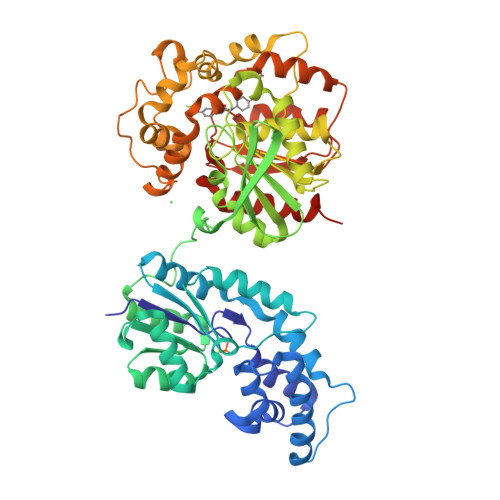Identification and optimization of soluble epoxide hydrolase inhibitors with dual potency towards fatty acid amide hydrolase.
Kodani, S.D., Bhakta, S., Hwang, S.H., Pakhomova, S., Newcomer, M.E., Morisseau, C., Hammock, B.D.(2018) Bioorg Med Chem Lett 28: 762-768
- PubMed: 29366648
- DOI: https://doi.org/10.1016/j.bmcl.2018.01.003
- Primary Citation of Related Structures:
6AUM - PubMed Abstract:
Multi-target inhibitors have become increasing popular as a means to leverage the advantages of poly-pharmacology while simplifying drug delivery. Here, we describe dual inhibitors for soluble epoxide hydrolase (sEH) and fatty acid amide hydrolase (FAAH), two targets known to synergize when treating inflammatory and neuropathic pain. The structure activity relationship (SAR) study described herein initially started with t-TUCB (trans-4-[4-(3-trifluoromethoxyphenyl-l-ureido)-cyclohexyloxy]-benzoic acid), a potent sEH inhibitor that was previously shown to weakly inhibit FAAH. Inhibitors with a 6-fold increase of FAAH potency while maintaining high sEH potency were developed by optimization. Interestingly, compared to most FAAH inhibitors that inhibit through time-dependent covalent modification, t-TUCB and related compounds appear to inhibit FAAH through a time-independent, competitive mechanism. These inhibitors are selective for FAAH over other serine hydrolases. In addition, FAAH inhibition by t-TUCB appears to be higher in human FAAH over other species; however, the new dual sEH/FAAH inhibitors have improved cross-species potency. These dual inhibitors may be useful for future studies in understanding the therapeutic application of dual sEH/FAAH inhibition.
Organizational Affiliation:
Department of Entomology and Nematology, and UC Davis Comprehensive Cancer Center, University of California, Davis, Davis, CA 95616, United States.






















